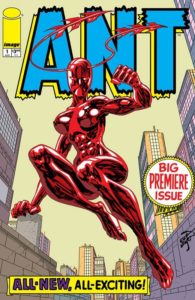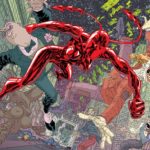
 For a comic that has only had 12 issues in almost 15 years, Ant has a complicated history. It started as a character and series created by Mario Gully. However, even before the first series started, Gully began to find interest in other avenues and moved on from the character. Enter Erik Larsen, who was a publisher at Image Comics when Ant first debuted. After some time, Larsen bought the rights to Ant from Gully, which brings us to the launch of the all-new series.
For a comic that has only had 12 issues in almost 15 years, Ant has a complicated history. It started as a character and series created by Mario Gully. However, even before the first series started, Gully began to find interest in other avenues and moved on from the character. Enter Erik Larsen, who was a publisher at Image Comics when Ant first debuted. After some time, Larsen bought the rights to Ant from Gully, which brings us to the launch of the all-new series.
Meet Hannah Washington, a young girl living with her single father. Her father is a good man, but he works long hours and is not always there for Hannah. Due to her father’s absence, Hannah tends to retreat to her journal where she draws and tells stories of herself as a hero. Unfortunately, the very people who kept her father away for long hours are also the people the world needs protection from.
Because of the confusing and disjointed history of the previous series, Erik Larsen decided to treat Ant #1 as a new origin story. In that sense, Larson has done an excellent job of creating a world that is easily accessible to new readers. The origin story, while a bit cliché, is easy to follow. And by the end of the first issue, the potential big bad is introduced, and Hannah’s life is changed forever.
Unfortunately, where Ant #1 succeeds on the foundation, it lacks in any depth. The relationship between Hannah and her father is glazed over, which softens the blow in the dramatic conclusion of Ant #1. Additionally, while Hannah has gained some powers, the only confirmation of what those powers are is mentioned in her journal. The problem is that those journals are in her head and not based totally on reality. Is this just a coincidence that the powers that she thought of are also the ones she gained? Or is there a connection between those journals and the work her father was doing? It just seemed to work out a little too well. The questions about Hannah’s powers are not the only plot points that are mentioned without any context. It ends up making the introduction of the character feel unfinished and ultimately bland.
Larsen has a long and storied career within the comicbook industry. That is why the lack of quality art in Ant #1 is surprising. The art lacks any depth throughout. Characters are stiff and unmoving. The linework is sloppy and leaves random lines on characters. Meanwhile, the few current-day views we get of any hearken back to the 1990s where the size of the character’s breasts is more important than her personality. Unfortunately, the art comes off as if an amateur drew it and leaves much to be desired.
Overall, Ant #1 feels like it is stuck a few decades in the past where the concept was first hatched. The lack of depth in storytelling and flat art screams of a creator with far less experience than someone of Erik Larsen’s caliber. For now, it is better to skip the series.





One thought on “[REVIEW] CAN ERIK LARSEN RESURRECT A CULT CLASSIC IN ‘ANT #1’?”